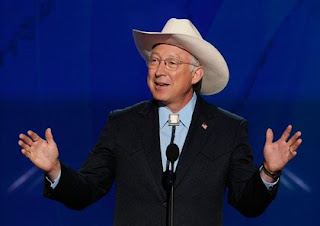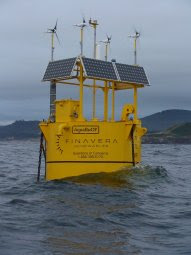
Short-term thinking dominates the analysis of our auto industry and more generally our future transportation and economic needs. By choosing short-term approaches over long-term solutions we guarantee the need for more short-term solutions.
The Automakers
There were lots of hybrid and electric vehicles at last month's North American International Auto Show (the Detroit Auto Show) and plenty of promises of more to come. The overriding theme was fuel efficiency; however, given Detroit's sometime disconnection from consumer desires, were they showing what consumers want to buy? This is a critical question for the automakers because they have been wrong in the past, producing the wrong kind of vehicle and being caught flat as consumer desires shifted. Following the oil shock years of the early 1970s the industry started building larger, heavier, and higher-powered vehicles culminating with the SUV craze of the last many years. Small, fuel-efficient car development atrophied and Detroit was unprepared for the shift to smaller, thriftier vehicles. Six months ago SUVs were shunned; now with gas at $2 per gallon, SUV sales have perked up while compacts and pricier hybrids have slumped.
Bob Lutz, General Motor's vice-chair of global product development saw a direct correlation between gas prices and consumer interest in the GM Cobalt, one of their more fuel-efficient vehicles at 30 mpg highway:
When it was $4 a gallon, we couldn't make enough... Now we have trouble pushing the Cobalts out to the dealers.
His difficulty with mercurial buyers was exceeded only by his exasperation with the demands from lawmakers that Detroit further increase fleet fuel efficiency:
It put us in the industry in the position where we are at war with the customer. Because the customer, given the gas prices, is going to want one thing. And we're going to be forced by regulation to produce something entirely different.
Ah, regulation, that bane of right-thinking industry executives everywhere. Uncertainty about government action weighs on auto executives:
“To really ramp up volume, we need a clear energy policy,” said Ford executive board chairman William Clay Ford at a private dinner during the show’s press previews. Without that, he said, “It’s really difficult to plan the volumes for our new models, and to know what product mix to offer.”
How clear must it be?
Three factors drive President Obama's emerging energy policy: reducing foreign oil dependence, creating more domestic energy jobs, and addressing climate change. All three lead to a bias towards high fuel efficiencies in domestic vehicles and the advancement of alternative methods of propulsion, such as biofuels and especially electrically-powered vehicles. While short-term specifics matter at the margins, the broad long-term direction of better fleet fuel economy could hardly be more clear.
The automakers could have and should have been leading this change, and they have only themselves to blame. Ray LaHood, the Secretary of Transportation designee, a Republican, states the obvious:
The car manufacturers knew this was coming. I don't think you're going to see them get a lot of heartburn over this.
LaHood may nonetheless want to send antacids to some of them, particularly GM, which seems to already being having problems digesting some of this. Regulations requiring the development and production of gas-stingy cars, says GM's Lutz, will be no more effective than combating obesity by forcing clothing manufacturers to make only small sizes. Yes, that probably doesn't work, but, to use Lutz' analogy, what will those who successfully lose weight wear? There is a market for fuel-efficient vehicles today, even with (temporarily) cheaper gas. Won't this market continue to grow and take market share from the gas guzzlers as oil and gasoline inevitably climb back and beyond higher levels?
Frank Klegon, head of product development at Chrysler foresees greater demand for more efficient cars not merely to respond to regulation but to "create a portfolio of cars that pull the market." Ford also sees what must be done:
Frankly, I think it’s a gamble not to do it. It’s clear that society is headed down this road.
They know that this is the future direction of the market, but are too timid to commit: Ford plans to build only about 10,000 electric vehicles per year to start. The fear certainly comes from not knowing how well the cars will sell in the short-term, which has become very hard to predict accurately. The fluctuating demand for the Cobalt is not unusual anymore. The car companies are less confident predicting market trends and market demand for their models than they have been since the Edsel.
In the long-term, however, the direction is clear. This will be the last time we see gas selling at $2 per gallon; the demand for more fuel-efficient vehicles is an upward trend. No company has the clairvoyance to perfectly predict future sales of a new product, but if you have a well-differentiated product that fills (and will fill) a real and compelling need--build it. And be ready with plans to rapidly ramp production when it takes off.
Are US automakers earnest about changing our transportation infrastructure, our transportation economy? Letting others seize the high ground of bold innovation has cost American competitiveness dearly in the automotive industry. What is needed is not larger engines or larger cup holders or cars that turn us on, but instead larger value as a transportation choice.
Happy Motoring
Short term thinking is not just the fault of Detroit; the car buyer also shares a large part of the blame, by making purchase decisions for ephemeral or emotional reasons. With gasoline low again, buyers have again forsaken long-term prudence for the seductive pleasures of massive engines with gas guzzling appetites.
Who needs a hybrid now that Happy Motoring days are here again?
In December, sales of Toyota’s Prius—the standard bearer of all hybrids—fell by a whopping 45%. In November, sales were off 48%. During those two months, gasoline prices plummeted below $2 a gallon. This proves that America hasn’t turned truly green. More likely, they turned red at the pump back in July when gasoline prices topped $4 a gallon. People fled their suvs and bought smaller cars and hybrids like there was a fuel shortage.
But once gasoline prices fell back to levels that Americans have normally paid, they pulled back on hybrid purchases. Toyota has indefinitely delayed its plans for a Prius plant in Mississippi. Toyota isn’t the only company feeling a pinch. Ford’s Escape hybrid and the competing Saturn Vue hybrid both saw sales sink by more than 40% last month. And the hybrid Civic? Off almost 70%. Ouch.
In tough times economic pessimism trumps green idealism, at least for most. Demand for pricey cars using advanced technology is strong at the
high-end of the market:
Another brave approach to green is being taken by small-volume, luxury automakers Fisker and Tesla. Fisker will start selling its $87,900 plug-in hybrid sports car at the end of this year. Henrik Fisker told Yale Environment 360 that more than 1,000 customers have put down $5,000 deposits, and that the recession—and low gas prices—have so far not dampened demand. Franz von Holzhausen of Tesla said in an interview that the company has delivered 160 of its $109,000 electric roadsters, and is aiming to sell 1,200 cars a year.
Buyers of these cars are perhaps less affected by broader economic concerns, and can afford to pay such sums. At the lower end, buyers are much more price-sensitive. When it comes to making cars that burn less gas, however, asking most consumers to do a careful analysis of the capital cost versus the operating cost of different vehicles is probably expecting too much. Hybrids cost more because they are more complex and because the battery technology is relatively new. R&D costs for battery development have not been recouped through sales and lower costs through manufacturing scale will not be significant until there is a much higher sales rate. Manufacturers hesitate to commit because the demand changes rapidly and unpredictably.
Even with lower oil and gas prices pocketbook issues have more of an impact on the behavior of manufactures and buyers than does economic policy.
Economics professor John Whitehead emphasizes
market forces:
During the summer of 2008, we were oh-so-achingly close to what economists call the Hotelling switch point. Named after the great economist Harold Hotelling, the switch point occurs when rising nonrenewable energy prices meet falling renewable energy prices and energy users switch from dirty nonrenewable energy (i.e., oil, coal) to cleaner renewable energy (i.e., wind, solar). In theory, nonrenewable energy prices are expected to rise over time as the available reserves begin to run out. Renewable energy prices are expected to fall as the technology available to harness energy from the wind and sun improves and reduces the costs of renewable-energy production. Rising incomes might also increase the demand for clean energy relative to dirty energy, further encouraging the switch.
Whitehead notes that we are farther now from the Hotelling switch point and that the price gap between renewable and non-renewable energy has widened. This is a short-term and temporary phenomenon which obscures the longer term reality: whether most consumers know it (or will admit it) the era of cheap Happy Motoring is over, and this is true regardless of whether one's wheels run on fossils or renewables. The issue is not how to find a cheaper ride because all rides will cost more.
Driving on Both Sides of the Street
Must government prop up both the supply and the demand side of the industry?
The reluctant support of the
Big Larger-Than-They-Should-Be 3 by the US taxpayer necessitates support also for the auto buyer. One main reason (among many) that Detroit has struggled has been that other auto makers have built products better matched to buyer preferences. Saving Detroit (for now) does little to encourage people to buy their products. So the US taxpayer (via government at various levels) must now also support the buyer, e.g. by
offering incentives in the form of rebates and tax credits to buy hybrid or electric vehicles.
However,
before as we commit the US taxpayer to open-ended financial support of both the manufacturers and the buyers of the US auto industry the question needs to be asked: what is the industry that we are committing to support? It is a staple of business school instruction to know what business you are in: many railroads failed with the advent of commercial trucking because they believed they were in the railroad business rather than the transportation business. (Today we see some companies realizing they are in the energy business, e.g. Conoco Philips and BP, and some forever grounded in the oil business, e.g. ExxonMobil, who pursues their own unique and, for now, highly profitable short-term strategy.)
The US auto industry is
endangered:
Like much of the rest of the world, Americans know that the U.S. automotive industry is in the grips of what may be a fatal decline. Unless it receives emergency financing and undergoes significant reform, it is undoubtedly headed for the graveyard in which many American industries are already buried, including those that made televisions and other consumer electronics, many types of scientific and medical equipment, machine tools, textiles, and much earth-moving equipment -- and that's to name only the most obvious candidates. They all lost their competitiveness to newly emerging economies that were able to outpace them in innovative design, price, quality, service, and fuel economy, among other things.
We can save our transportation sector, including our transportation industry and transportation economy without saving the
Big Larger-Than-They-Should-Be 3. To do so, however, requires thinking about our needs as a country for transportation over the next several decades rather than thinking about the needs of the workers over the next several paychecks, of the suppliers over the next several invoices and of the executives over the next several quarters of Wall Street judgement. This is not to say that the needs of these latter groups are not important or should be ignored. Quite the contrary, they will be critical to the success of any recapitalization or restructuring of the automotive industry (although new leadership in the C-suite might be salutary.)
Desperate for Vision: Can our Future Survive our Present?What's needed is long-term, strategic thinking about what our transportation infrastructure could and should be in 20 years, the role the automotive industry will play, and how we get from here to there. What's not needed is short-term, politically timid bailouts that simply feed the beast, elevating hope over reason in thinking that this squall will pass and we all go back to the way it was.
The decision of what to do is further distorted by fundamental disagreement over what the future looks like. While some cling to the belief that this is just another cyclical disturbance on our way back to the same old normal, others see the mounting evidence that the Age of Oil is ending, and disagree only about how precipitous that end will be.
T. Boone Pickens looks to energy policy to lead: “The free market is fine, but waiting on the free market sometimes can be disastrous.” Sadly, we have seen again in the past week that government action may not be any better when it is dominated by short-term thinking and the
mindless idolatry of tax cuts and automobile worship.
Tuesday the US Senate (the so-called "World's Greatest Deliberative Body") produced its latest link in a chain of sausages, a stimulus bill with some decidedly unsavory ingredients. Any bill of this size will have elements that are wasteful or feckless; this bill has some which are both, such as auto supports, which additionally represent
lazy thinking by lawmakers:
Take the $11.5 billion in tax incentives for automobile purchases. As Ryan Avent argues, "the attempt to support automobile purchases is regressive -- if you're comfortable enough to buy a new car in these economic times, you probably aren't among the most in need of scarce government assistance. It will also fare poorly as stimulus. It's unclear how many sales might be generated by the plan or whether the number will be large enough to increase production or will merely serve to draw down the massive automobile inventory overhang already sitting on lots."
It's also dangerous as a long-term measure: It accelerates the purchase of cars with no requirements for fuel efficiency. Limiting the assistance to extremely efficient automobiles would have at least pushed the industry in the right direction. Using a cash-for-clunkers approach -- where the credit is for those who turn in old, inefficient cars and purchase new, highly efficient vehicles -- would have ensured the credit proved both progressive and environmentally sane. As it is, the $11.5 billion -- more than transit receives in the whole bill -- will go to subsidize the well-off and worsen our carbon problem. It's two counterproductive policies for the price of one!
Today's action to meld the House and Senate versions of the stimulus has apparently watered down some of the automotive inducements and has further reduced the amount of the "infrastructure" spending devoted to public transit. The lion's share of the transportation dollars go once again to highway construction and the Cult of Happy Motoring.
There are some signs that the stirrings of real leadership may come from the states. Texas Republican Governor Rick Parry, hardly a fan of government regulation or climate change activism isn't waiting on the federal government to take the right action; he's supporting the automotive future himself:
Rather than wait for more mandates and punishments for environmental non-attainment, let’s continue encouraging innovation. I support giving Texans ... a $5,000 incentive towards a purchase of Plug-In Hybrid Electric Vehicles, using the funds Texans have already paid to reduce emissions.
This approach, while not perfect, at least creates incentives to build part of what must be the future of our transportation infrastructure.
A Bad Diet
Said Goethe, allegedly:
Then indecision brings its own delays,
And days are lost lamenting over lost days.
Are you in earnest? Seize this very minute;
What you can do, or dream you can do, begin it;
Boldness has genius, power and magic in it.
Congress, and particularly the
Republicans in the House really don't get it. Short-term thinking and a short-term sugar rush of stimulus may be useful to jolt the economy into action, but action without purpose is simply frenzy. And when the sugar buzz wears off, the resulting enervation will prompt calls for... more stimulus!
What the country needs instead is a coherent and cogent vision, with the long-term funding, tools, and commitment needed to achieve it. We need a bold plan, not the sad compromise emerging from Congress that sacrifices our future for the political expediency of the present. We need solid nutrition to restore the health and build the vitality of the economic body, not lollipops, sweet and giddy-making in the moment that confirm us as spoiled and indulged children, easily distracted and all too willing to eat political junk food.
 President Obama addressed the country before a joint session of Congress tonight. It was not technically a State of the Union address, which was just as well, as it relieved Obama from the unpleasant chore of finding an suitably precipitous adjective too replace that used in the shopworn bromide, "The state of our Union is strong." Instead he said that
President Obama addressed the country before a joint session of Congress tonight. It was not technically a State of the Union address, which was just as well, as it relieved Obama from the unpleasant chore of finding an suitably precipitous adjective too replace that used in the shopworn bromide, "The state of our Union is strong." Instead he said that








